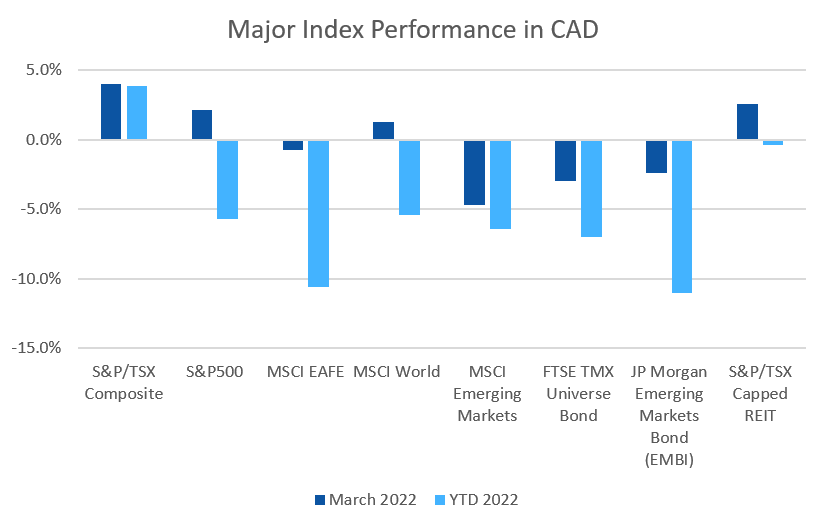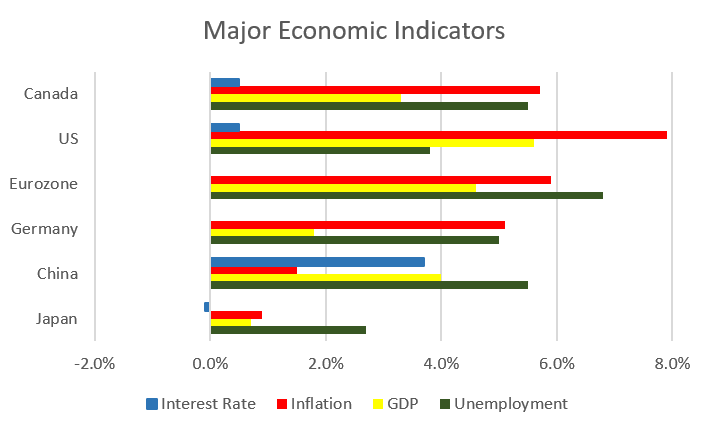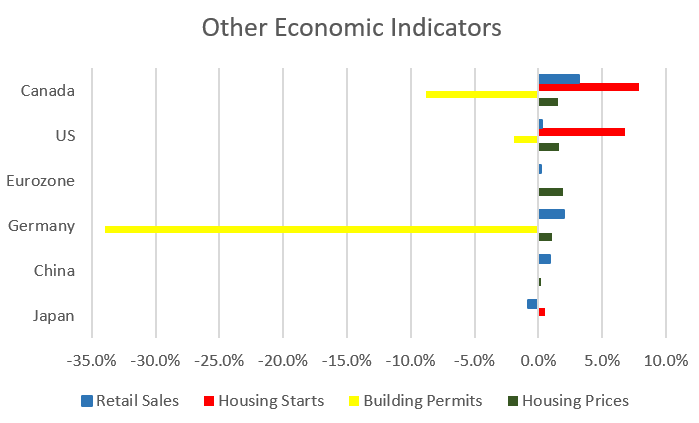March was a good month for equity markets around the world, while bonds continued to suffer.
March 2022 Market Performance
All index returns are total return (includes reinvestment of dividends) and are in Canadian Dollars unless noted.
| Other Market Data | Month-end Value | Return for March 2022 | 2022 YTD Return |
|---|---|---|---|
| Oil Price (USD) | $100.28 | +4.51% | +33.33% |
| Gold Price (USD) | $1,949.20 | +2.17% | +6.60% |
| US 3 month T-bill | +0.52% | +0.17%* | +0.46%* |
| US 10 year Bond | +2.32% | +0.49%* | +0.80%* |
| USD/CAD FX rate | 1.2496 | -1.59% | -1.44% |
| EUR/CAD FX rate | 1.3853 | -2.70% | -3.74% |
| CBOE Volatility Index (VIX) | 20.56 | -31.81% | +19.40% |
*Absolute change in yield, not the return from holding the security.
The S&P/TSX Composite was one of the best performers in March, gaining +4.0%, and is now positive for 2022. The S&P/TSX Small Cap also performed strongly, gaining +3.6%. US markets also performed well; the large cap S&P500 gained +3.7% (in USD), while the index of US small cap stocks, the Russell 2000, gained +1.1%, and the tech focused Nasdaq gained +3.4% in March. All of those US stock market indexes remain in the red for 2022.
The broad index of EAFE (Europe, Australasia & Far East) stocks gained +1.6% in March. Out of the EAFE regions, European stocks were a little worse off at +0.4%, meanwhile British stocks were up +0.8%. EAFE is down -4.4% for 2022, European stocks -5.9%, and British stocks are up +1.8% for 2022. Japanese stocks were up +3.4% for March. Emerging market stocks were one of the few negative performers in March, losing -2.3% for the month, and -6.5% in 2022.
Bond markets continue to struggle with the prospect of higher interest rates; all indexes we track posted their third negative month in a row, with many having their worst quarter in decades.
The major Canadian bond index, the FTSE/TMX Universe Bond Index lost -3.0% in March, bringing the YTD loss to -7.0% – the worst quarter since the first quarter of 1994. The FTSE/TMX Short-term Bond Index lost -1.9% in March, and is down -3.0% for 2022. In the US, investors sold the higher grade bonds heavily again, while high yield was spared the worst of the losses. The ICE BoA AAA index lost -2.4% for March, bringing the YTD loss to -8.5%. The BBB index performed a little worse in March at -2.8%, and -8.2% for 2022. High yield bonds lost -1.0% in March for the HY Master II Index and the CCC and lower (the real junky stuff) Index. Emerging market bonds were down -2.4% for March and -11.0% (!) for 2022 – their worst quarter in history (well, since the index was created).
REITs were positive in March, gaining +2.6% for the month, though they remain negative for 2022 at -0.4%.
Oil surpassed the US $100 per barrel level for the first time since July 2014, gaining +4.5% in March, and it is up +33.3% for 2022. Gold gained +2.2% for March. The diversified Bloomberg Commodities Index gained +8.6% in March, and it’s up +25.5% for 2022.
In March the Canadian Dollar (CAD) lost -0.7% against the US Dollar, and gained +1.2% against the Euro.
March 2022 Economic Indicator Recap
Below are the readings received in March for the major economic indicators: central bank interest rates, inflation, GDP and unemployment.
Below are the current readings on a few other often followed economic indicators: retail sales and housing market metrics.
A Closer Look at the Canadian Economy
Canada’s unemployment rate dropped a full percent from 6.5% to 5.5% in February, finally returning to pre-pandemic levels and only 0.1% from the lowest rate on record. The economy added 336,600 jobs, 121,500 were full time jobs, and 215,100 were part time jobs. The job gains were concentrated in the services sector, with accommodation and food services, and information, culture and recreation the biggest gainers.
Housing prices across Canada were up +1.5% in February, with all 11 major markets again contributing to the gains. The top gainers were again Hamilton (+4.0%), Victoria (+2.5%), and Toronto (+2.0%). The annual national price gain for the 12 months ended January 31 was +17.7%; Halifax was almost double that at +32.5%.
The level of new housing starts rose +7.9% to 247,200 units in February. Urban housing starts rose +10%, driven by multifamily (condo and townhouse) construction. The value of building permits issued declined -8.8% in January to $10.2 billion, driven by a -11.6% decline in residential construction; non-residential construction declined -2.7%. On a provincial basis, BC declined -26.5% and NB declined -24.7%.
The inflation rate for February was +1.0%, and +5.7% on an annual basis – the highest annual inflation rate since August 1991! Oil prices hit levels not seen in over a decade, which impacted most areas of the economy. The cost of shelter rose +6.6%, the sharpest monthly increase since 1983. Transportation and food prices rose more than +6% as well. Energy prices were also a major contributor, as gasoline prices rose +31.7%. Core inflation which excludes more variable items such as gasoline, natural gas, fruit & vegetables and mortgage interest was +4.8%.
Retail sales were up +3.2% in January, with 9 of 11 sectors posting increases. New car dealers, grocery stores and general merchandise stores were the largest gainers. Compared to a year ago, retail sales were up +12.0%.
Canada’s GDP grew +0.2% in January. The goods producing sectors grew +0.8%, led by construction (+2.8%) and utilities (+4.0%). The services sectors were flat as the effects of the latest COVID-19 variant were felt.
As expected, after months of inflation higher than we’ve seen in more than a decade, the Bank of Canada raised interest rates +0.25% to +0.50% at the March 2nd meeting. The benchmark interest rate is expected to remain at its current low levels until into second half of 2022. The BoC expects inflation to remain elevated for the first half of 2022, after which they expect inflation to ease, although the invasion of Ukraine and the rapid rise in energy prices creates additional uncertainty for interest rate forecasters.
*Sources: MSCI, FTSE, Morningstar Direct, Trading Economics



